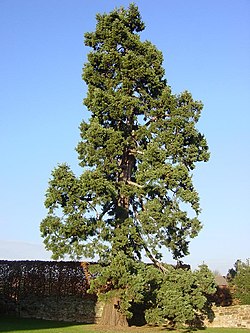樹
See also: 树
Translingual
Han character
樹 (Kangxi radical 75, 木+12, 16 strokes, cangjie input 木土廿戈 (DGTI), four-corner 44900, composition ⿰木尌)
References
- Kangxi Dictionary: page 551, character 29
- Dai Kanwa Jiten: character 15496
- Dae Jaweon: page 940, character 5
- Hanyu Da Zidian (first edition): volume 2, page 1287, character 4
- Unihan data for U+6A39
Chinese
| trad. | 樹 | |
|---|---|---|
| simp. | 树 | |
| alternative forms | 𣗬 Min | |

Glyph origin
| Historical forms of the character 樹 | |
|---|---|
| Shuowen Jiezi (compiled in Han) | |
| Shizhoupian script | Small seal script |

|

|
Phono-semantic compound (形聲/形声, OC *djoʔ, *djos) : semantic 木 (“wood”) + phonetic 尌 (OC *djos).
Etymology
Area word (Schuessler, 2007): Mizo tuh (“to plant, to sow”), Khmer ដុះ (doh, “to grow, to bud”). Starostin compares it with Tibetan གདོས (gdos), གདོས་པ (gdos pa, “mast”) and Burmese ထူ (htu, “to erect (a post), to raise (a flag)”).
Related to 豎 (OC *djoʔ, “to erect; to make vertical”).
Pronunciation
Lua error in Module:wuu-pron at line 162: Incorrect tone notation "3" for sh. See WT:AZH/Wu.
Definitions
- † to plant; to place upright; to cultivate
- † to set up; to establish
- tree (Classifier: 棵 m; 株 m; 樖 c; 叢/丛 mn; 頭/头 h)
- plant
- (graph theory) tree
- a surname
Synonyms
Dialectal synonyms of 樹 (“tree”) [map]
Compounds
Lua error in Module:zh/templates at line 32: This template has been deprecated. Please use Template:col3 instead.
Japanese
Kanji
樹
Readings
Etymology 1
| Kanji in this term |
|---|
| 樹 |
| き Grade: 6 |
| kun'yomi |
| For pronunciation and definitions of 樹 – see the following entry. | ||
| ||
| (This term, 樹, is an alternative spelling (uncommon) of the above term.) |
Etymology 2
Proper noun
- a male given name
Korean
Hanja
Vietnamese
Han character
(deprecated template usage) 樹 (thụ)
- This term needs a translation to English. Please help out and add a translation, then remove the text
{{rfdef}}.
Categories:
- Translingual lemmas
- Translingual symbols
- Han script characters
- Han phono-semantic compounds
- Chinese lemmas
- Chinese hanzi
- Chinese terms with obsolete senses
- Chinese nouns classified by 棵
- Chinese nouns classified by 株
- Chinese nouns classified by 樖
- Chinese nouns classified by 叢/丛
- Chinese nouns classified by 頭/头
- zh:Graph theory
- Chinese surnames
- Beginning Mandarin
- Japanese kanji
- Japanese sixth grade kanji
- Japanese kyōiku kanji
- Japanese jōyō kanji
- Japanese kanji with goon reading じゅ
- Japanese kanji with goon reading ず
- Japanese kanji with kan'on reading しゅ
- Japanese kanji with kun reading う・える
- Japanese kanji with kun reading き
- Japanese kanji with kun reading た・てる
- Japanese terms spelled with 樹 read as き
- Japanese terms read with kun'yomi
- Japanese nouns
- Japanese lemmas
- Japanese terms spelled with sixth grade kanji
- Japanese terms with 1 kanji
- Japanese terms spelled with 樹
- Japanese single-kanji terms
- Japanese terms with uncommon senses
- Japanese proper nouns
- Japanese terms with multiple readings
- Japanese given names
- Japanese male given names
- Korean lemmas
- Korean hanja
- Vietnamese lemmas
- Vietnamese Han characters
